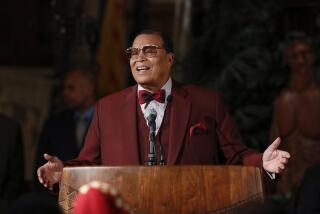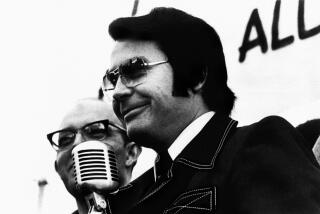Re-examining Race : HISTORY : Beyond the Fringe: Is Coughlin a Model?
- Share via
WASHINGTON — Addressing a vast crowd in the shadow of the Capitol, Louis Farrakhan briefly sounded more like a would-be Ross Perot than a self-proclaimed prophet of God.
“What we want is not necessarily a third party,” declared the leader of the Nation of Islam, “but a third force, which means that we’re going to collect Democrats, Republicans and independents around an agenda that is in the best interests of our people.”
Two days later, Farrakhan announced he’ll participate in a voter-registration drive to build a base for “a third political power” not linked to any party.
In the aftermath of the huge turnout for the Million Man March on Monday, Farrakhan’s plunge into politics raises the question of whether he’s able to move from the margins to the mainstream of African American leadership and national politics. Can a religious movement built on the anger and aspirations of an embattled minority move from social protest to the electoral process? Can a fiery preacher build coalitions, make compromises and reach beyond his core constituency?
Some 60 years ago, another minister and another movement attempted a similar journey. As with the Nation of Islam, this movement originated in Depression-era Detroit, appealed to ethnic grievances, espoused theo-political absolutism, sold a weekly newspaper on the city streets and influenced many beyond its membership. Like Farrakhan, its leader was a spellbinding orator who won applause with his appeals for justice but attracted controversy with his attacks on Jews.
The leader was Father Charles Coughlin, an Irish-American priest who mobilized millions during the 1930s with radio broadcasts, mass meetings, a weekly newspaper and an appeal for economic justice and social harmony. Coughlin’s story is a cautionary tale for Farrakhan, because the “radio priest” fell from prominence to disgrace when his third-party movement foundered and his rhetoric became stridently anti-Semitic.
As a parish priest in the Detroit suburb of Royal Oak in 1926, Coughlin was outraged when the anti-Catholic Ku Klux Klan burned a cross in his church yard. Seeking to explain his faith, he asked a Detroit radio station for air-time.
By the ‘30s, Coughlin’s Sunday afternoon broadcasts attracted an audience of 30 million throughout the nation. In the depths of the Depression, when working-class Americans lost jobs and hope, Coughlin’s radio talks supported progressive Catholic social thinking. He criticized the excesses of “modern capitalism,” supported labor unions and even called Franklin D. Roosevelt’s New Deal “Christ’s deal.”
From the start, Coughlin’s concerns were moral as well as material. Already appalled by the intolerance that had contributed to the defeat of their co-religionist Al Smith’s presidential campaign in 1928, American Catholics were among those whose sense of social order was shaken by the Depression.
As historian Michael Kazin writes in “The Populist Persuasion,” Coughlin “spoke more to his followers’ loss of psychological security and the nation’s apparent fall from social harmony than to the oppression of American workers.” Coughlin’s blend of economic populism and social conservatism was enormously attractive.
But Coughlin’s love of the limelight took him from progressivism to paranoia. New Deal Democrats and a growing labor movement pushed new leaders forward who addressed working people from all backgrounds; among these unifying figures were prominent Catholics, including New York’s Democratic Sen. Robert F. Wagner, author of the National Labor Relations Act, and the labor leader Philip Murray, a founder of the Congress of Industrial Organizations. Overshadowed by these mainstream figures, Coughlin became more shrill and more hate-filled in pursuit of audiences and applause.
In 1936, Coughlin helped start a third party, which nominated GOP Rep. William Lemke of North Dakota for President. Coughlin bragged: “If I don’t deliver 9 million votes for William Lemke, I’m through forever.” But Lemke got only 892,000 votes, and Coughlin descended into intolerance and irrelevance.
While Coughlin had earlier revealed a fixation with Jews, his rhetoric became unmistakably anti-Semitic. He defended Nazi attacks on Jews as a “defense reaction” against power. He reprinted excerpts from the notorious “Protocols of the Elders of Zion” in his weekly newspaper, Social Justice. And, as World War II approached, he became increasingly strident in his isolationism.
Soon, Coughlin was repudiated by his fellow Catholics. As early as 1936, a leading Catholic liberal, Msgr. John Ryan, attacked Coughlin as “disastrous to the great majority of the American people, particularly to the wage earners.” In 1941, shortly before Pearl Harbor, Archbishop Edward Mooney ordered Coughlin to stop his broadcasts and, a year later, to stop publishing Social Justice. Forbidden to speak out on national politics, he retired in 1966 and died in obscurity in 1979.
While Coughlin’s journey took him from respectability to marginality, Farrakhan may yet move from the fringes to center stage--but only if he moves away from the extremism that destroyed the “radio priest.”
As he demonstrated at the start of his speech at Monday’s march, when he praised the founders of the Nation of Islam, Farrakhan still preaches a dogma that emerged in the ‘30s. As historian C. Eric Lincoln writes in “The Black Muslims in America,” the movement began with an itinerant peddler who called himself Master Wallace Fard Muhammad and proselytized door-to-door in Detroit’s ghetto. His leading disciple was a minister’s son and unemployed auto worker who took the name Elijah Muhammad. As Lincoln explains, Elijah Muhammad “cut his cloak from the cloth available,” espousing a brand of Islam that stresses “black pride and black dignity.”
After Muhammad’s death in 1975, his son and heir, Warith Deen Muhammad, steered the sect toward orthodox Islam. Three years later, Farrakhan split with the younger Muhammad, leading a group that follows the elder Muhammad’s racialist doctrines.
Like Coughlin, Farrakhan denounces Jewish “international bankers,” and some Farrakhan followers sell copies of the anti-Semitic “Protocols” in their bookstores. But, on the positive side, as did Coughlin, Farrakhan builds his movement more on pride than prejudice.
Thus, many African Americans who shun the Nation of Islam’s more extreme dogmas share its emphasis on black unity and self-reliance. The nation is respected for its ability to reach out to and rehabilitate people whom the economy has discarded and the political system disregarded. And, to be sure, the great majority of men at the Million Man March came not because of Farrakhan but to make a public commitment to take greater personal responsibility for themselves, their families and their communities.
With Coughlin’s example looming from the past, will Farrakhan become a powerful presence on the national scene, retreat into extremism and isolation--or shuttle back and forth between both stances?
Extremists and hatemongers flourish in desperate times and political vacuums. For many African Americans, conditions approach the hurt and hopelessness that most Americans experienced in the Depression. But, while the 1930s produced social movements and national leaders that competed with Coughlin and eventually isolated him, few mainstream leaders and organizations appeal to those who follow Farrakhan today.
So Farrakhan is enjoying his moment on the national stage. His moment may last as long as mainstream leaders avoid the problems he emphasizes, creating a vacuum for Farrakhan to fill. If Farrakhan seized the opportunity to offer solutions and not scapegoats, he may become the historic figure he proclaims himself to be. But if he offers little more than rage and rancor to people who hunger for hope and help, history suggests that his moment will pass.*
More to Read
Sign up for Essential California
The most important California stories and recommendations in your inbox every morning.
You may occasionally receive promotional content from the Los Angeles Times.













